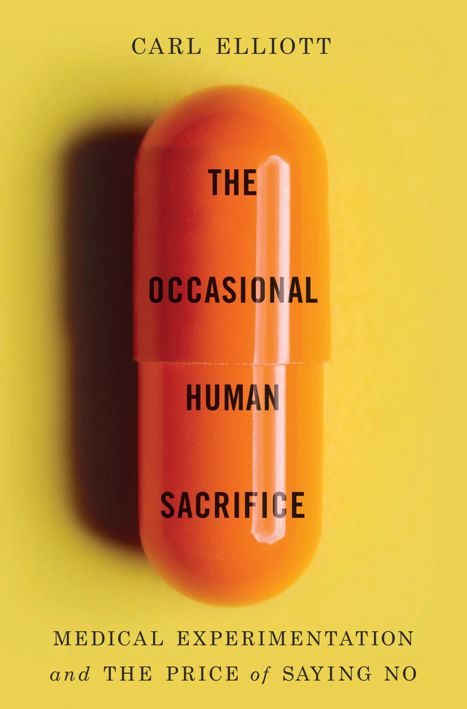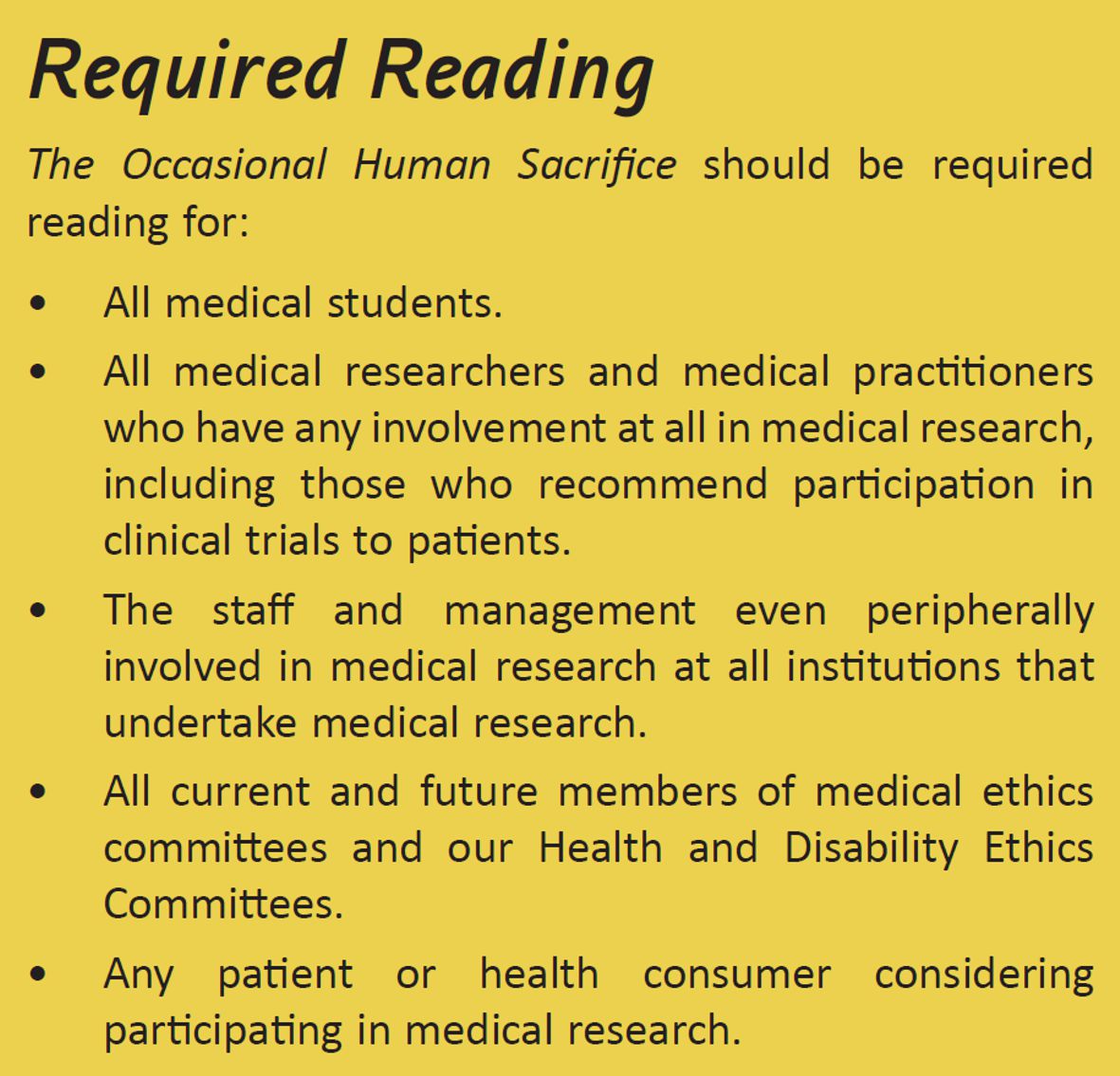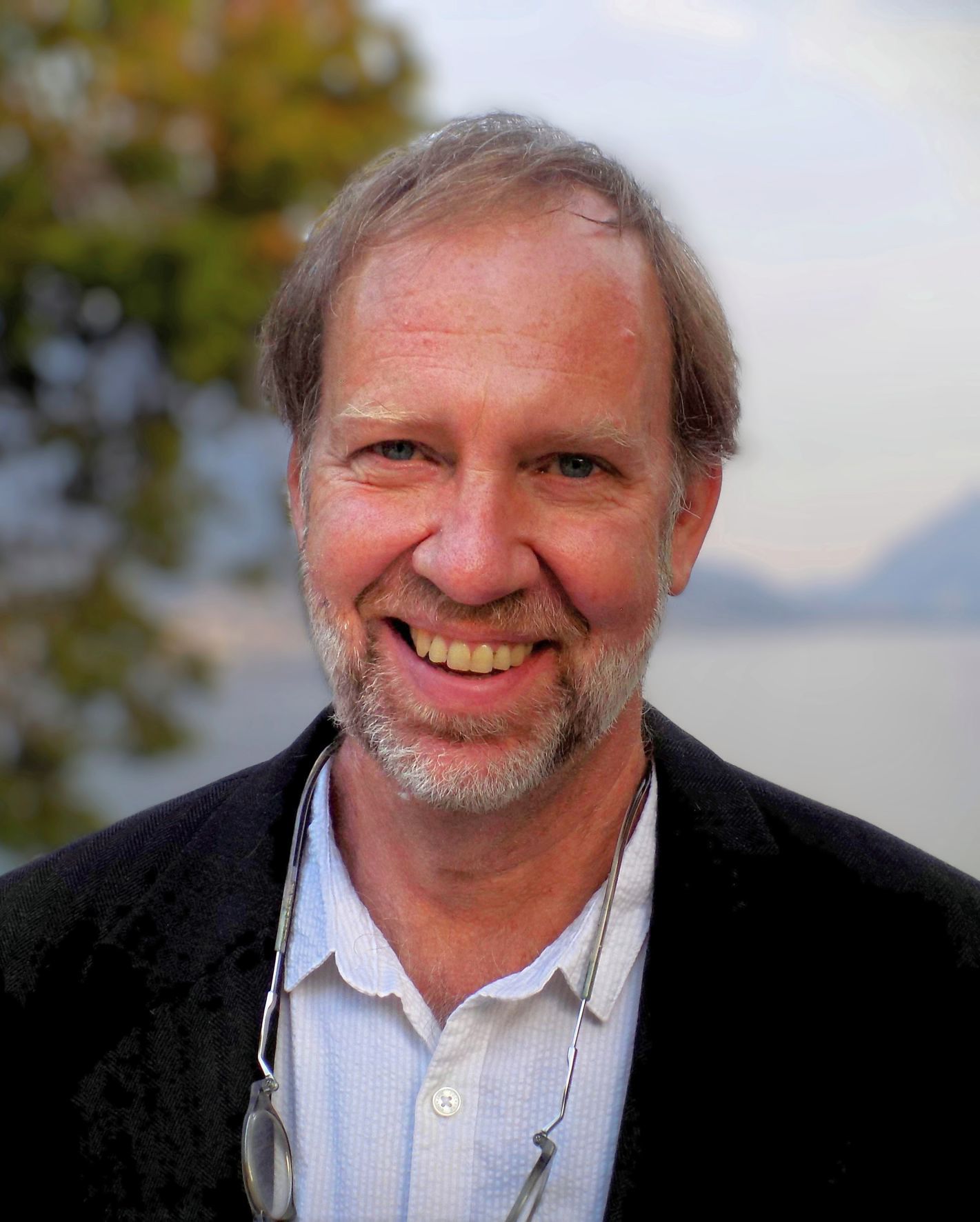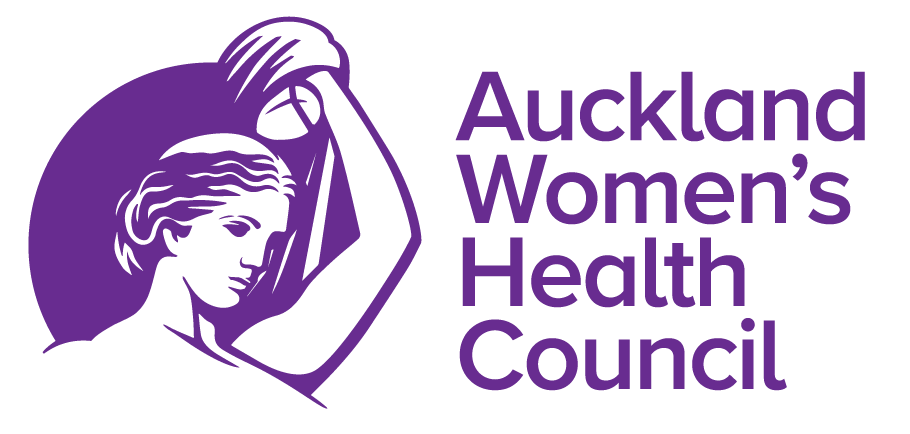The Occasional Human Sacrifice:
medical experimentation and the price of saying no
Book Review
The Occasional Human Sacrifice: Medical Experimentation and the Price of Saying No by Professor Carl Elliott
Book review by Sue Claridge
In his very first sentence in the Introduction of The Occasional Human Sacrifice, Carl Elliott characterises himself as a coward, and sets out his credentials as a coward.
Having met Prof Elliott, having read his book and about his work, and his own efforts to blow the whistle on abuses in medical research, I’m pretty sure he is not a coward. There is a difference between not being brave enough, as a third-year medical student on rotation, to defy the orders of the senior physicians overseeing this critical part of your medical training, and being an actual coward.
The difficulties that medical students face in speaking out against breaches of patient rights that they observe happening in our teaching hospitals — and no doubt in the teaching hospitals in the US — are well documented. New Zealand research published in 2022 revealed that medical students found it very difficult to stand up to senior physicians and supervisors over issues of ethics, patient rights and consent.[1]
Dr Phillipa Malpas, Honorary Associate Professor in Clinical Medical Ethics at the University of Auckland, when interviewed for a 2022 article in the AWHC Newsletter on this issue[2], said:
“[It] appears that the significant power imbalance between trainee doctor and senior supervising doctor, results in a perpetuation of an attitude that patient rights simply don’t matter.”
“Certainly, I think the significant power imbalance between students and their seniors is a factor in why some medical students struggle with speaking up and instead, ‘do what they are told’ – often against the students’ wishes.”
If this is still the case in the relatively “enlightened, post-Cartwright early 21st century of Aoteroa New Zealand, imagine how much harder it must have been to speak up in Elliott’s time as a medical student in the 1980s in the US.
Elliott’s description of his time as a medical student is an excellent introduction to the main subject of his book – the moral struggle and experience of whistleblowers in a medical context. The Occasional Human Sacrifice is less about the depraved and unethical treatment of human beings in medical experiments, than it is about those principled human beings who were determined to blow the whistle on abuses of patients in those medical experiments; medical experiments that patients neither consented to participate in, nor were even aware that they had somehow been caught up in.
After describing his own experience as a whistleblower on unethical psychiatric research at the University of Minnesota (where he still works), in which a young man lost his life, Elliott devotes a chapter to each of six notorious stories of shocking abuses of patients in medical research:
- the Tuskegee syphilis experiments on poor black men;
- the Willowbrook hepatitis experiments on intellectually disabled children;
- the Fred Hutchinson Cancer Research Center lethal bone marrow transplant experiments
- the University of Cincinnati lethal total body irradiation experiments;
- New Zealand’s National Women’s Hospital experiments on women with carcinoma in situ; and
- Paolo Macchiarini’s lethal synthetic tracheal transplant experiments at the Karolinska Institute.
With relative restraint, Elliott gives us just enough detail about the excruciating harm – and often death – suffered by people on whom qualified and senior doctors experimented; just enough detail to understand how truly depraved and unconscionable these experiments were.
It is hard not to be affected by the agonising deaths of almost 90 cancer patients who had total body irradiation having been told it was a new treatment for their cancers. In fact, they were unwitting ‘guinea pigs’ in experiments for the US military to better understand what would happen to soldiers exposed to nuclear radiation.
It is hard not to be affected by the intellectually disabled children living in abject squalor at Willowbrook – a state-sponsored institution that was overcrowded and had poor sanitation, and where hepatitis A was rife with between 30 and 53% of children contracting the disease. Children not already infected, were fed chocolate milk contaminated by faeces collected from other children at Willowbrook, to test whether gamma globulin protected against hepatitis A. Other children were deliberately injected with the much more dangerous hepatitis B – a disease they would not otherwise have been exposed to at Willowbrook – in order to test a hepatitis B proto-vaccine.
Then there is Yesim Cetir, a young Turkish woman who died after 191 surgical procedures over five years, as the result of a horrifically botched exploratory thoracotomy at the Karolinska Institute that left her with a burst trachea and one lung so damaged it was removed. She received two defective synthetic tracheal transplants a year apart, both of which failed, and she required unrelenting medical attention for years, including multiple organ transplants in the US. By the time she died she had suffered two strokes, had lost part of her vision and couldn’t walk.
And “Phoebe”, one of Herbert Green’s research subjects. Over a period of years Green had refused to accept that her condition was malignant despite the clinical evidence and pathology. When whistleblower Dr Ron Jones took over her care while Green was overseas, she was haemorrhaging so badly from an enormous tumour that she had to be transfused with 12 units of blood – more than her entire blood volume. Dr Jones operated, but the surgery was only palliative.
No matter how difficult it is to read about these, and the many other people who were unwitting, unconsented ‘experimental subjects’, they provide critical context to the stories of the whistleblowers. The book is, throughout its pages, an in-depth look at what characterises whistleblowers, what drives them to speak out against colleagues, medical practitioners and researchers more powerful and well connected than they. It is a story about what happens to whistleblowers, who are typically pilloried, vilified and ostracised; some lost their jobs. In the Karolinska case, the whistleblowers were declared guilty of scientific fraud alongside Paolo Macchiarini.
Elliott met with the whistleblowers and spent time with them, in an effort to understand what drove the whistleblowers to speak out about the abuses they witnessed while so many others kept quiet. As an academic – a bioethiscist – and a whistleblower himself, he takes a deep dive into the literature on whistleblowers, not just those in a medical or health setting.
A recurring theme is the relative naïveté that many of the whistleblowers set out with; a belief that if they only exposed what was going on, those in a position to address such shocking abuses of patients would sit up and take notice. Even if they didn’t expect to be thanked, many whistleblowers expected that the perpetrators of the six unethical experiments would be held to account, would be stopped. The reality was that, while many of the whistleblowers sacrificed years of their lives, sometimes their careers and their reputations, suffered inordinate levels of stress, and lost friends and family, the perpetrators were rarely punished, and some were – and still are – held up as heroes.



Professor Carl Elliott
Whistleblowers in Aoteroa New Zealand
The Protected Disclosures (Protection of Whistleblowers) Act 2022, which came into force on 1 July 2022, can protect people when making disclosures about serious wrongdoing in or by their organisation. It should almost always protect them from being identified if they make their disclosure to their organisation, and in a medical or health context, to the Ministry of Health and/or the Health or Disability Commissioner, and likely if they disclose to the Medical Council.
Christian Poland says, in the HCAA report Are Our Medical Harm Reporting Systems Effective? Are People Safe? that a medical professional is unlikely to be protected under the Act when reporting harm caused by a colleague at a different hospital/institution, even if they have reasonable grounds to believe the serious wrongdoing occurred.
This is because, in order for a disclosure to be “protected”, the serious wrongdoing must be “in or by the discloser’s organisation”: s 9(a).
“So that was probably one of the most shocking things, that nobody really gave a shit. And I wasn’t prepared for that.”
— John Pesando on his efforts to expose lethal bone marrow transplant experiments at the Fred Hutchinson Cancer Research Center
The six case studies are all quite different from each other in many aspects, although the experiences of the whistleblowers substantially overlap. However, the fallout from ‘unfortunate experiment’ in Aoteroa New Zealand has some quite unique aspects.
Dr Ron Jones is the sole surviving whistleblower from a group of three that included Dr William McIndoe, cytologist and colposcopist, and Dr Malcolm (Jock) McLean pathologist. Together with statistician Peter Mullins, Jones, McIndoe and McLean published a paper in 1984 in the journal Obstetrics and Gynecology. This paper exposed Herbert Green’s research, which involved withholding treatment from women with abnormal cervical smear,s that ultimately led to many women developing invasive cervical cancer; 33 women died.
Were it not for Sandra Coney and Phillida Bunkle’s Metro article in 1987, what was revealed in the 1984 Obstetrics and Gynecology paper may never have properly seen the light of day. The Metro article came about as a direct result of the paper and Sandra Coney’s introduction to Clare Matheson, one of Green’s ‘guinea pigs’.
The public response to the revelations in the Metro article was outrage; the Government’s response was to very quickly – within ten days – establish a judicial inquiry headed by [then] District Court Judge Silvia Cartwright.
Of all the stories in The Occasional Human Sacrifice, the uncovering of New Zealand’s own unethical medical experiment has probably led to the most significant and widespread change in our health system and our attitudes to both medical research and patient rights, especially informed consent, than in any other case in Elliott’s book.
While there are still some who deny the facts, repudiate the outcomes of the Cartwright Inquiry, and seek to all but canonise Herbert Green, by and large, the ‘unfortunate experiment’ has been a lesson reasonably well learned and has changed the ethics around medical research in this country. RANZCOG, the former Auckland District Health Board and former Prime Minister Jacinda Ardern all issued public apologies.
What is missing from Carl Elliott’s book is that the victims of Herbert Green’s unethical and abhorrent experiments – and the whistleblowers who ensured that what he did was exposed and addressed in a formal inquiry – are not forgotten, even 36 years after the Inquiry. Unlike many victims in the other stories, the legacy that whistleblowers Ron Jones, Jock McLean and Bill MacIndoe (together with Sandra Coney and Phillida Bunkle) have left, is that the victims are remembered. They are remembered every year on the 5th of August, the anniversary of the release of the Cartwright Report. The Auckland Women’s Health Council and the Cartwright Collective, and other organisations such as the Maternity Services Consumer Council, have, over the last 36 years, made a pilgrimage to the old National Women’s Hospital to remember what the women endured, the loss of life, and the sacrifice of their families, and of the men who tried to stand up to Herbert Green and who ultimately spoke out irrespective of the impact that might have on their lives and reputations.
Each year we hold space for those who were so badly affected by Herbert Green’s unethical medical experiment.
Carl Elliott knew of our pilgrimage to the old National Women’s Hospital at Greenlane every year. He told me in an email discussing his New York Times essay (see the reprint in our Newsletter here), his book and talk on the 5th of August that one of our Committee members had sent him some photos and told him about our annual gathering and commemoration. He said:
“I found it incredibly moving. I don’t know of anything like that happening anywhere else in the world.”
I would like to think that medical research abuses such as those Carl Elliott covers in his book are well in the past and could not happen today. However, the horrific events at the Karolinska Institute occurred quite recently, between 2011 and 2016. We must stay vigilant; we must not be complacent, thinking that it would be impossible for such shocking abuses of patients to happen again, even in Aoteroa New Zealand. While patient rights have improved since the Cartright Inquiry, there are still grey areas regarding the involvement of patients in medical research, especially patients that are unconscious or incapacitated, and this very issue is included in the current Health and Disability Commissioner review of the Act and Code of Health and Disability Services Consumers’ Rights. Since the Helsinki Declaration in 1964, which is a statement of ethical principles for medical research involving human subjects, the participation of human beings in medical research without their knowledge or consent has been prohibited. Yet, formalised, ratified prohibition at an international level has not prevented such abuses from happening here and overseas.
We must remain vigilant.
“Let not anyone pacify his conscience by the delusion that he can do no harm if he takes no part, and forms no opinion. Bad men need nothing more to compass their ends, than that good men should look on and do nothing.”
— John Stuart Mill, 1867
[1] Bhoopatkar H, et al., 2022: Adherence to a national consensus statement on informed consent: medical students’ experience of obtaining informed consent from patients for sensitive examinations, New Zealand Medical Journal, 2022 May 20; 135(1555).
[2] Claridge S, 2022: Patient Rights: Informed Consent in our Teaching Hospitals, Auckland Women’s Health Council Newsletter, August 2022.
